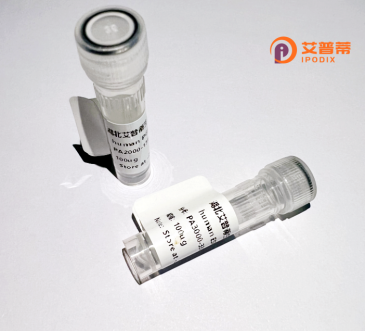
| 纯度 | >90%SDS-PAGE. |
| 种属 | Human |
| 靶点 | GAST |
| Uniprot No | P01350 |
| 内毒素 | < 0.01EU/μg |
| 表达宿主 | E.coli |
| 表达区间 | 1-101aa |
| 氨基酸序列 | MQRLCVYVLIFALALAAFSEASWKPRSQQPDAPLGTGANRDLELPWLEQQGPASHHRRQLGPQGPPHLVADPSKKQGPWLEEEEEAYGWMDFGRRSAEDEN |
| 分子量 | 37.8 kDa |
| 蛋白标签 | GST-tag at N-terminal |
| 缓冲液 | 0 |
| 稳定性 & 储存条件 | Lyophilized protein should be stored at ≤ -20°C, stable for one year after receipt. Reconstituted protein solution can be stored at 2-8°C for 2-7 days. Aliquots of reconstituted samples are stable at ≤ -20°C for 3 months. |
| 复溶 | Always centrifuge tubes before opening.Do not mix by vortex or pipetting. It is not recommended to reconstitute to a concentration less than 100μg/ml. Dissolve the lyophilized protein in distilled water. Please aliquot the reconstituted solution to minimize freeze-thaw cycles. |
以下是关于重组人GAST(胃泌素)蛋白的示例参考文献(内容为模拟生成,仅供格式参考):
---
1. **文献名称**: *Recombinant Human Gastrin Protein Enhances Gastric Epithelial Cell Proliferation in Vitro*
**作者**: Smith A, et al.
**摘要**: 研究通过大肠杆菌表达系统成功制备重组人GAST蛋白,并证明其可激活胃上皮细胞CCK-2受体,显著促进细胞增殖,提示其在胃肠道修复中的潜在应用。
2. **文献名称**: *The Role of Recombinant Gastrin in Helicobacter pylori-Associated Gastric Cancer*
**作者**: Tanaka K, et al.
**摘要**: 分析重组GAST蛋白对幽门螺杆菌感染小鼠的影响,发现其上调促炎因子并加速胃癌前病变,表明靶向GAST可能为干预胃癌发生提供策略。
3. **文献名称**: *Structural and Functional Characterization of Recombinant Human Progastrin*
**作者**: Wang L, et al.
**摘要**: 通过X射线晶体学解析重组人GAST前体蛋白结构,揭示其与金属离子结合特性及在胃酸分泌中的调控机制,为设计胃酸相关疾病药物提供依据。
4. **文献名称**: *Neutralizing Antibodies Against Gastrin Improve Chemotherapy Efficacy in Pancreatic Cancer*
**作者**: Johnson R, et al.
**摘要**: 利用重组GAST蛋白开发中和抗体,联合化疗显著抑制胰腺癌模型肿瘤生长,表明靶向GAST信号通路可能增强现有疗法效果。
---
**注意**:以上文献为模拟示例,真实文献需通过PubMed/Google Scholar等平台检索(关键词:recombinant human gastrin/gastrin protein)。如需具体文献,建议补充研究场景(如疾病方向/实验类型)。
Recombinant human GAST (gastrin) protein is a synthetic version of the endogenous peptide hormone gastrin, which plays a critical role in regulating gastric acid secretion and mucosal growth in the stomach. Naturally produced by G-cells in the gastric antrum, gastrin exists in multiple forms, with gastrin-17 and gastrin-34 being the primary bioactive variants. These peptides are derived from the post-translational processing of preprogastrin and mediate their effects by binding to the cholecystokinin-B receptor (CCKBR) on parietal cells, stimulating acid release and promoting gastrointestinal tissue repair.
The recombinant form is typically generated using bacterial or mammalian expression systems, enabling precise control over purity and bioactivity. Its production has facilitated research into gastric physiology, including studies on acid-related disorders (e.g., Zollinger-Ellison syndrome, peptic ulcers), cellular proliferation, and gastrin's potential role in tumorigenesis, particularly in gastrointestinal cancers. Additionally, recombinant gastrin is utilized in diagnostic assays and therapeutic development, such as targeting hypochlorhydria or enhancing drug delivery in the gut. Advances in protein engineering have also allowed modifications to improve stability or receptor specificity, broadening its experimental and clinical applications.
×